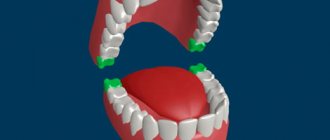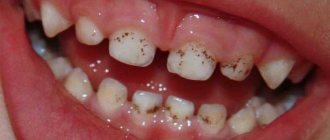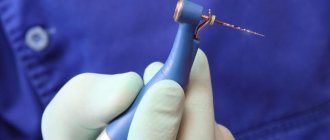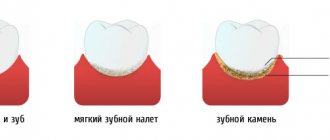What could be the consequences?
The problem most often manifests itself exclusively from an aesthetic point of view - psychological problems arise, the patient wants to correct the pathology as quickly as possible, especially if it is pronounced. That is, if the teeth and gums are healthy, then such discomfort is the only consequence of the problem.
If the short size of the crowns is caused by an abnormal structure of the teeth, problems with the gums, or abrasion of the enamel, then the consequence of this condition may be inadequate chewing of food, which will inevitably lead to problems with the gastrointestinal tract, premature aging of the face and the appearance of deep wrinkles near the mouth, and general deterioration dental conditions and even their loss.
The structure of the human jaw: teeth and their formula
When citing one number for any tooth, the dentist means its anatomical and functional affiliation. If you conditionally divide the dentition into two halves and start counting from the first incisor, you will get 8 teeth in each direction (top and bottom). The first incisor is a one. The second, accordingly, is a deuce. And so on until the last molar, which is called the figure eight. If the doctor says - bottom seven on the left, then we are talking about the bottom left second molar. As you can see, everything is very simple!
This can be expressed schematically as follows (permanent teeth):
For baby teeth, everything is the same, only the teeth are designated by Roman numerals (there are no premolars in the primary dentition):
As for the two-digit designations, they were invented in order to simplify the written recording of medical history. The above is preserved, but a number appears before the number indicating which jaw and on which side the tooth is located. Conventionally, the oral cavity is divided into segments - upper right (number 1), upper left (number 2), lower left (number 3), lower right (number 4). As you noticed, the report is conducted starting from the top right and clockwise. The segment is written first, and then the tooth number. For example, the third canine from the top right would be designated tooth 13. The lower incisor on the left is 32 teeth. In children, the segments are designated by numbers 5 to 8, so as not to confuse the primary bite with the permanent one. Let's take the same third fang on the right. In a child, it will be designated as tooth 53. And so on by analogy. The main thing is to always start the report from the right side at the top, then you won’t get confused. These are not snails with 25 thousand teeth! Can you imagine their dental formulas?
Treatment methods
The treatment method for this pathology is selected based on the cause that caused it. If the teeth and gums are in good condition, then it will be enough to perform gum surgery or install veneers, which will lengthen the crown part. If inflammation is present, then the treatment tactics should be identical to the methods for solving the problem of periodontitis. In any case, a visual examination, diagnosis of the condition of teeth and gums, followed by the development of an individual rehabilitation plan will be required.
Trimming the labial frenulum The labial frenulum is usually very short, which results in exposed teeth. But in a number of situations, on the contrary, it can be excessively long and literally hangs over the crowns. In such a situation, the size of the crowns naturally becomes smaller. Plastic surgery of the frenulum will solve the problem - this involves cutting off part of the mucous membrane and suturing it. The procedure can be performed at almost any age. Local anesthesia is required.
Price:
5000 rubles more about the solution
Gumplasty The doctor visually lengthens the teeth by trimming the gums and changing the position of the gingival contour. The operation is only permissible on healthy gums and teeth. At the same time, it may be necessary to carry out a remineralization procedure, since the part of the teeth that is located under the gums is more susceptible to external mechanical influences. If a large volume of mucous membrane was trimmed, additional microprosthetics will be required using veneers or lumineers.
Price:
from 6,000 rubles more about the solution
Veneers and lumineers Thin onlays allow you to correct many aesthetic defects in the dentition. Microprostheses are created from ceramic composite, ceramics or zirconium dioxide. If you have short teeth, they allow you to change their height, but only in the front part of the row, since they will simply break off on the lateral chewing elements. Prosthetics are often combined with gingival contour plastic surgery.
Price:
from 15,000 rubles more about the solution
Tooth roots
The processes of bone tissue - the roots of the tooth, hold it in the jaw - and in this they are very similar to the roots of plants. But, in addition, in each root process there is a void inside - this is the root canal. The same nerve fibers and capillaries that go higher into the pulp, and from below are brought out into the jaw through a tiny hole at the tip of the tooth root, are laid in it, like wires in a protective cable. This hole is called apical.
Depending on the type and size of the tooth, there may be one root, or there may be two.
Prevention measures
It is impossible to completely guarantee protection against the gradual separation of the gums from the tooth, because this will happen naturally with age, but you can slow down this process. Experts in the field of periodontology and dentistry have identified several basic recommendations, following which you can minimize the risk of gum recession:
- The first thing you need to do is systematically visit the dentist 2-3 times a year as a preventative measure.
- You need to give up bad habits or reduce them to a minimum.
- Enrich your daily diet with fresh fruits and vegetables.
- Perform hygiene procedures at least 2 times a day, in the morning and before bed. If desired, you can supplement brushing with dental floss.
- If you suspect or have any symptoms of any oral disease, consult a doctor immediately.
Regular dental checkups are something that most people neglect. Therefore, you need to develop a habit that will help keep your teeth healthy.
It is important to know! If your gums are your weak spot, you need to brush your teeth very gently, using a soft toothbrush and mouthwash. A hard brush can harm the gums and cause them to separate over time.
Gum recession is not just an aesthetic problem. This phenomenon signals the presence of a more serious disease or ongoing pathological processes in the soft tissues of the gums. Any deviation from the normal state should alert you and cause a visit to the dentist.
Treatment of generalized moderate and severe periodontitis
Catarrhal and hypertrophic gingivitis symptoms and treatment in adults
Laser gingivotomy - surgical treatment of complex forms of periodontitis
Laser gingivectomy in the area of one tooth
Splinting teeth for periodontitis with fiberglass and tape
Open and closed curettage of periodontal pockets
Treatment Options for Gum Recession
After finding out the main reason that caused such an unpleasant phenomenon, treatment can begin. When treating gum recession, the primary goal is to preserve the tooth and prevent future weakening of the gum tissue.
Receding gums are always a consequence of some disease or pathological process. As for treating the recession symptom, modern medicine can offer several ways to eliminate such an unpleasant defect:
- Professional oral hygiene against plaque and deposits . In this type of cleaning, you need to focus on deposits in the gum pockets. Regularly carrying out such a procedure under the supervision of a dentist is the best way to prevent gum peeling and many other dental diseases.
- Treatment using the Vector device . This device takes teeth cleaning to a new level; the advanced German Vector technology perfectly helps to cope with the removal of tartar and plaque. The device releases ultrasonic waves that are safe for the body, but prevent harmful infusion on deposits in the oral cavity.
- Gum curettage is a procedure that helps to effectively get rid of deposits and plaque, and also, if necessary, normalize the condition of bone tissue. There are 2 options for carrying out this procedure. The first option, “closed curettage,” is recommended for patients whose periodontal pockets are no more than 5 mm deep and inflammatory processes have not yet penetrated deep into the bone. The second option is “open curettage” for pockets with a depth of more than 5 mm. In such a situation, the doctor makes a small incision in the gum, thereby peeling off a small section of it to gain access to the bone tissue and tooth root. Then the doctor carries out an antiseptic treatment; if there is bone atrophy, bone chips are planted to restore its normal state.
- Plasmolifting. This type of lifting involves the direct introduction of special autoplasma into problem areas, which is previously isolated from the patient’s blood. Before the procedure, you need to donate about 15 ml of blood, from which the doctor will separate plasma. Such plasma contains an increased number of platelets and protein. Then this liquid enters the gums through an injection and promotes its restoration.
- Vestibullasty of the gums. This method involves a surgical intervention during which a piece of healthy gum is transplanted to the site of the damaged one. After such treatment, long-term drug therapy is prescribed.
- Treatment with vitamins. In the early stages of gum recession, gum recession can be treated by taking a special set of vitamins and professional cleaning. In such a situation, the patient is usually prescribed vitamins A, D, B9, C. It is their lack that weakens the gums.
In the case when the gum recession is too advanced and the tooth is already clearly loose, it is necessary to undergo a splinting procedure (combining the moving parts of a row into a new group and fixing it in the desired position). For fixation, a thin aramid thread is usually used, which is attached to the back of the row, or a prosthesis with claw-shaped branches is installed under each loose tooth.
It is worth noting that sometimes, when the gums have almost exposed the root, the tooth is very loose and is in poor condition, the best solution is to remove it. In the future, an implant can be installed in its place, which will be indistinguishable from a real tooth. Such an implant is the only option to preserve a beautiful smile and jaw functionality.










